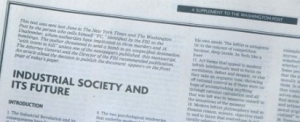This article was originally published on The 1995 Blog and has been republished with permission.
It may not have been courageous necessarily, but the joint decision by the Washington Post and New York Times 20 years ago to publish the Unabomber “Manifesto” certainly cut against the grain of media criticism that warned against yielding to a terrorist’s demands.
The “Manifesto” was a 35,000 word screed written by a reclusive and anonymous serial killer who, from time to time over a 17-year period, mailed or placed bombs that killed three people and injured 23 others. Universities and airlines were his early targets, and he came to be called “Unabomber.”
The Unabomber’s final victim, Gilbert P. Murray, was killed April 24, 1995, by a parcel bomb sent to his office in Sacramento, where he was president of the California Forestry Association.
As I note in my latest book, 1995: The Year the Future Began, the year was “remarkable for the frequency with which terrorism intruded.” Five days before the attack that fatally injured Murray, the federal building in Oklahoma City was the target of a massive truck bomb that killed 168 people and injured more than 600 others. The month before that, members of a Japanese cult attacked the Tokyo subway system with Sarin gas, killing 12 people.
Less than two months after Murray’s death, the Unabomber sent his “Manifesto” (titled “Industrial Society and Its Future”) to the Post and Times, threatening to kill again unless the newspapers published the typewritten treatise that railed against evils of modern technology. In an accompanying letter, he gave the newspapers a three-month deadline to comply.
The terrorist’s demands set off a vigorous debate among journalists and media watchers, many of whom said they opposed publishing the document. To do so, they argued, would be tantamount to surrendering to blackmail, not to mention ceding news judgment to the demands of a serial killer.
“My instinct is that [publication] is a very bad idea, and takes the press down the wrong trail,” Everette E. Dennis, then head of a media studies center in New York, told the Post. “A news organization should really not be in the business of public safety and police work.”
Rem Rieder, then editor and senior vice president of the now-defunct American Journalism Review, pointed to a troubling precedent that publishing the screed might establish.
“My instinct is that this is the wrong way to go,” Rieder said after the “Manifesto” was published. “It sets a very dangerous precedent, particularly since there is so much anger out there, with people going to such a great extent to express their rage.
“This is like turning over a newspaper at gunpoint.”
The screed was published, unaltered, on September 19, 1995, as an eight-page pullout supplement in the Post. The newspapers shared printing costs and their publishers said in a joint statement that they had decided to publish the treatise “for public safety reasons.”
The FBI, which the Unabomber had taunted in a letter to the Times in April 1995, favored publication, as did then U.S. attorney general, Janet Reno.
Richard Ault, a former FBI agent who periodically worked on the Unabomber case, said after reading the “Manifesto”:
“The manuscript is as lovingly prepared as his bombs. Somewhere along the way, he has had these conversations before. Someone who would read this might say: ‘This sounds like so and so.’”
That, more or less, is what happened. David Kaczynski and his wife read portions of the “Manifesto” online, visiting a college library to do so.. They devoted weeks to scrutinizing the document, noting similarities to the views and writings of his estranged elder brother, a brilliant Harvard graduate and former college professor named Theodore J. (Ted) Kaczynski.
Through intermediaries, David Kaczynski eventually shared his suspicions with the FBI and in April 1996, Ted Kaczynski was arrested at his primitive cabin in the woods near Lincoln, Montana.
At trial in 1998, Kaczynski pleaded guilty to charges related to his campaign of bombings.
In statements in federal court before Kaczynski was sent to prison, Susan Mosser, the widow of one of his victims, implored the judge: “Please keep this creature out of society forever. Bury him so far down he’ll be closer to hell, because that’s where the devil belongs.”
Kaczynski was sentenced to eight life terms and is imprisoned at Super Max, the ultra-high-security complex in Colorado sometimes called “Alcatraz of the Rockies.” Serving time there, a Super Max former warden has said, is “much worse than death.”







